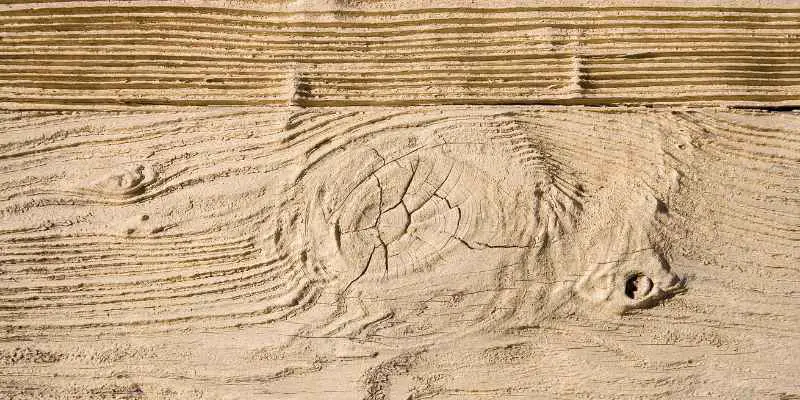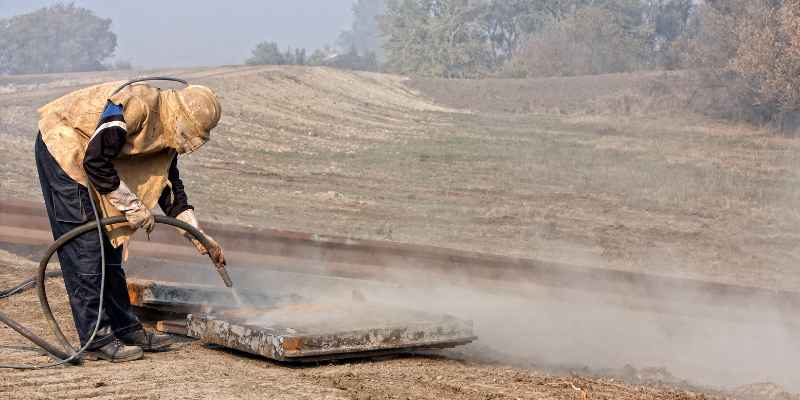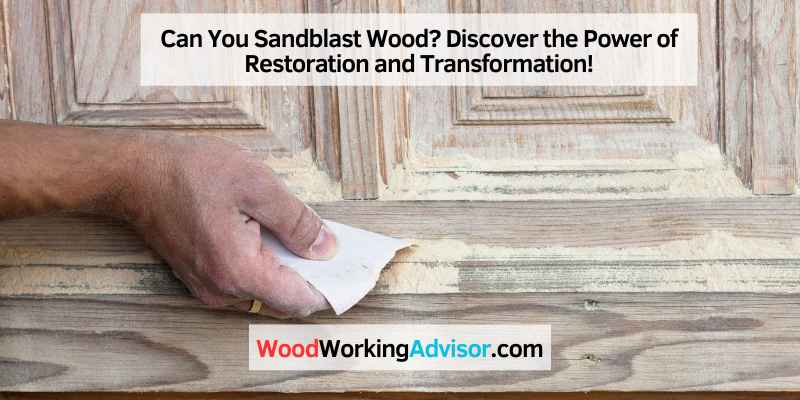Yes, wood can be sandblasted to remove paint, stain, or other coatings, revealing the original wood surface. Sandblasting is an effective method for restoring wood by using abrasive particles propelled at high velocity to dislodge the unwanted material.
It helps to smooth the surface, preparing it for refinishing or simply to bring out the natural grain of the wood. Whether it’s an old furniture piece, exterior siding, or a wooden floor, sandblasting can be a viable option for revitalizing wood surfaces.
However, it’s important to note that sandblasting can be aggressive and may cause damage if not done correctly, so it’s best to consult a professional to ensure proper technique and safety measures are followed.
The Art Of Sandblasting Wood
Have you ever wondered if you can sandblast wood? Sandblasting is a fascinating technique that can transform the appearance and texture of wood surfaces. In this article, we will explore the incredible art of sandblasting wood and how it can breathe new life into your woodworking projects.
What Is Sandblasting?
Sandblasting is a method used to remove surface imperfections or unwanted finishes from wood by forcibly propelling abrasive materials, such as sand or aluminum oxide, at high speeds using compressed air. This process effectively removes layers of material from the wood, revealing a fresh and clean surface.
How Does Sandblasting Work?
During the sandblasting process, the abrasive material is directed towards the wood surface using a specialized sandblasting gun or nozzle. The force of the propelled particles erodes the top layers of the wood, effectively removing stains, paint, varnish, and other unwanted substances.
Sandblasting can be done in a controlled environment, such as a sandblasting booth or cabinet, which helps contain the abrasive material and prevents it from spreading. The speed and pressure at which the abrasive material is projected can be adjusted, allowing for precise and customized results based on the desired effect.
The key to successful sandblasting lies in finding the right balance between removing the undesired layers without causing damage to the underlying wood. Professional sandblasters have a deep understanding of different wood types and the appropriate abrasives to use, ensuring a flawless and uniform finish.
Pro Tip: Before starting the sandblasting process, it is important to prepare the wood surface by cleaning it thoroughly and removing any loose particles or dirt. Additionally, wearing appropriate safety gear, such as goggles and a respirator, is crucial to protect yourself from the abrasive materials and dust.

Benefits Of Sandblasting Wood
Sandblasting wood offers numerous benefits such as efficient paint removal, improved surface texture, and enhanced durability. It is a highly effective method to restore and rejuvenate wood surfaces without causing any damage.
There are several advantages to sandblasting wood, making it an excellent method for restoring and refinishing wooden surfaces. Whether you’re working on furniture, flooring, or other wood fixtures, sandblasting can offer some impressive benefits:
Removes Old Paint And Finishes
Sandblasting is an effective way to remove old paint, coatings, and finishes from wood surfaces. By using high-pressure sand particles, the process strips away layers of unwanted materials, revealing the natural beauty of the wood underneath. Whether you’re dealing with cracked paint or worn-out varnish, sandblasting can effortlessly remove them, leaving you with a fresh canvas to work with.
Restores Natural Wood Grain
One of the most appealing aspects of sandblasting wood is its ability to restore the natural wood grain. Over time, wood surfaces can become dull and worn, losing their original charm. However, sandblasting gently removes the top layers of the wood, bringing back its natural color, texture, and pattern. The result is a rejuvenated surface that showcases the inherent character and beauty of the wood.
Prepares Wood For Refinishing
In many cases, sandblasting is a necessary step when refinishing wood. Before applying a new coat of paint, stain, or sealant, it’s essential to prepare the surface properly. Sandblasting smoothens the wood, creating a clean and even base that ensures better adhesion for the refinishing products. By removing imperfections, such as scratches, dents, and raised grain, sandblasting helps achieve a flawless finish that enhances the durability and longevity of the wood.
In conclusion, sandblasting wood offers numerous benefits for restoring and refinishing projects. From removing old finishes to revealing the natural wood grain and preparing surfaces for refinishing, this technique proves to be a valuable asset for anyone looking to revitalize and enhance the beauty of wood.
Types Of Wood Projects Suitable For Sandblasting
When it comes to wood projects, sandblasting is a versatile and effective method for restoration and rejuvenation. Whether you’re looking to breathe new life into old furniture, revitalize a weathered deck or fence, or refine cabinets to their former glory, sandblasting can be the answer. In this article, we will explore three types of wood projects that are perfect candidates for sandblasting: furniture restoration, deck and fence rejuvenation, and cabinet refinishing. Let’s dive in!
If you have old, worn-out furniture that has seen better days, sandblasting can be a game-changer. This method removes layers of paint, varnish, or any other coating, exposing the natural beauty of the wood. Whether it’s an antique dresser, a family heirloom, or a vintage chair, sandblasting can bring back their original charm. By stripping away years of grime and damage, you’ll have a fresh canvas ready for refinishing or staining. It’s amazing how sandblasting can transform even the most tired-looking furniture into stunning pieces that look brand new.
Your deck or fence withstands the elements day after day.
Over time, they can become weathered, discolored, and worn down. But fear not, sandblasting can come to the rescue! By employing this powerful technique, you can effortlessly strip away years of built-up dirt, paint, or stain, revealing the natural wood grain hidden beneath. Sandblasting not only rejuvenates your deck or fence but also prepares the surface for a fresh coat of sealant or stain. With a renewed appearance, your outdoor space will be ready to impress and provide a comfortable setting for relaxation and entertainment.
If your kitchen or bathroom cabinets are looking outdated or in need of a facelift, sandblasting can be a cost-effective and efficient solution. With sandblasting, you can easily remove old paint or finish, allowing you to start anew. By meticulously blasting away the layers of wear and tear, you can prepare your cabinets for a fresh coat of paint, stain, or varnish. This process not only enhances their appearance but also extends their lifespan, giving you a budget-friendly option to transform your space without the need for expensive replacements.
In conclusion, sandblasting is a powerful technique that can bring new life to a wide range of wood projects. From furniture restoration to deck and fence rejuvenation, and even cabinet refinishing, the possibilities are endless. By harnessing the power of sandblasting, you can uncover the natural beauty of wood while revitalizing your space. So why wait? Give your wood projects the love they deserve and consider sandblasting for remarkable results!
Safety Precautions For Sandblasting Wood
Sandblasting is a popular method for refinishing and restoring wood surfaces. However, it is important to take the necessary safety precautions to protect yourself and the environment when sandblasting wood. In this section, we will discuss the essential safety measures to follow before starting your sandblasting project.
Protective Gear And Clothing
Wearing the proper protective gear and clothing is crucial to ensure your safety while sandblasting wood. The high-speed abrasive particles used in sandblasting can cause serious injuries if they come into contact with your skin or eyes. Here are the key protective items you should have:
- Safety goggles: Shield your eyes from particles and debris that may fly off during the sandblasting process.
- Dust mask: Protect your lungs by wearing a dust mask or respirator to filter out harmful particles and dust.
- Gloves: Use heavy-duty gloves to shield your hands from abrasive materials and prevent injuries.
- Protective clothing: Wear long sleeves, pants, and a hooded coverall to protect your body from flying debris and abrasive particles.
Work Area Preparation
Preparing the work area properly is essential for a safe sandblasting experience. Follow these steps to ensure a well-prepared work area:
- Cover nearby objects: Use plastic sheets or tarps to cover any nearby objects or surfaces that you want to protect from sandblasting abrasives.
- Isolate the work area: Create a designated workspace by isolating the area with barriers or screens to prevent particles from spreading beyond the intended sandblasting zone.
- Secure loose items: Remove or secure any loose items in the work area that could be dislodged or damaged by the sandblasting process.
Proper Ventilation
Adequate ventilation is crucial to maintain a safe environment during sandblasting wood. Here are some tips to ensure proper ventilation:
- Open windows and doors: If possible, open windows and doors to allow fresh air to circulate in the work area.
- Use exhaust fans: Position exhaust fans strategically to help remove dust, fumes, and particles from the air.
- Consider using a dust collector: A dust collector can help capture and filter fine particles generated during the sandblasting process, improving air quality in the workspace.
By following these safety precautions, you can minimize the risk of accidents and injuries while sandblasting wood. Remember to always prioritize your safety and take the necessary steps to protect yourself and your surroundings.

Tips And Techniques For Successful Wood Sandblasting
Discover the essential tips and techniques for achieving successful wood sandblasting. Learn whether sandblasting wood is a viable option and gain valuable insights to enhance your woodworking projects.
When it comes to wood sandblasting, employing the right tips and techniques can make a significant difference in achieving the desired results. By focusing on choosing the right abrasive material, adjusting pressure and nozzle size, and maintaining consistent sandblasting patterns, you can enhance the effectiveness and efficiency of your wood sandblasting project.
Choosing The Right Abrasive Material
Selecting the appropriate abrasive material is crucial for effective wood sandblasting. Various materials offer different levels of abrasiveness and work better for specific applications. Here are some popular abrasive materials to consider:
- Garnet: This red mineral is a common choice for wood sandblasting due to its moderate hardness and minimal risk of damaging the wood surface.
- Crushed Glass: Often used for delicate wood sandblasting, crushed glass provides a gentle abrasive action without causing excessive damage or leaving deep scars on the wood.
- Walnut Shells: Walnut shell abrasives are biodegradable and environmentally friendly, making them a smart choice for wood sandblasting. They are effective at removing paint and coatings without harming the wood.
- Aluminum Oxide: With its durability and ability to remove tough coatings, aluminum oxide is a popular choice for sandblasting hardwood surfaces. However, caution should be taken to prevent excessive impact that could damage the wood.
Adjusting Pressure And Nozzle Size
Another critical aspect of successful wood sandblasting is adjusting the pressure and nozzle size to achieve the desired results without harming the wood. Consider the following tips when adjusting pressure and nozzle size:
- Start with lower pressure settings and gradually increase if necessary to minimize the risk of damaging the wood surface.
- Opt for a nozzle size that balances the desired level of abrasiveness with precision. Smaller nozzle sizes provide more focused blasting, while larger ones cover a broader area.
- Test different pressure and nozzle size combinations on a small, inconspicuous area of the wood to ensure optimal results before proceeding with the entire surface.
Maintaining Consistent Sandblasting Patterns
Achieving an even sandblasting pattern is essential for a professional-looking finish. Consistency helps avoid uneven spots and excessive material removal. Consider these tips to maintain consistent sandblasting patterns:
- Maintain a uniform distance between the sandblasting nozzle and the wood surface as you work. This ensures consistent results across the entire project.
- Use a steady, sweeping motion when sandblasting, moving the nozzle in a consistent pattern to prevent concentrated blasting on certain areas.
- Periodically check the sandblasting pattern to ensure evenness and make adjustments as needed.
Conclusion
Sanding wood can be a highly effective method for restoring its beauty and bringing out its natural grain. However, sandblasting wood offers a more efficient and faster alternative, especially for large projects. By stripping away layers of dirt, paint, and stain, sandblasting can help revive weathered or damaged wood.
Remember to follow safety guidelines and choose the appropriate abrasive material to avoid damaging the wood surface. Consider sandblasting as a viable option to transform your wooden surfaces with ease.


